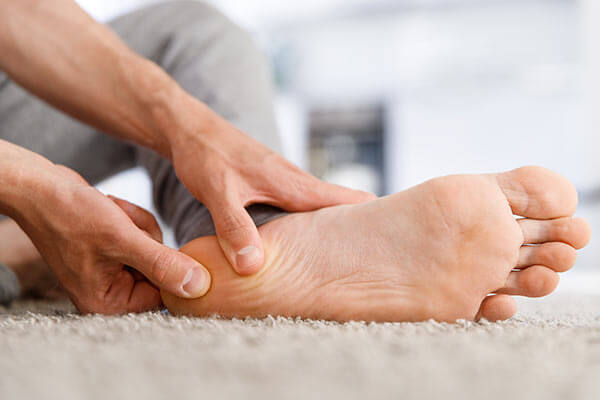Plantar Fasciitis Treatment Bowden
Struggling with heel pain that’s affecting your ability to work, exercise, or go about your day? Plantar fasciitis could be the underlying cause.


What is Plantar Fasciitis?
The plantar fascia is a thick band of tissue that stretches along the bottom of your foot, from the heel to the toes. It supports the arch of your foot and plays a vital role in comfortable movement. Plantar fasciitis occurs when this tissue becomes inflamed, often leading to severe heel pain.
Heel pain is the most common injury treated at the Adelaide Heel Pain Clinics. Our specialist clinic near Bowden manages around 50 cases daily, with plantar fasciitis being the most frequent diagnosis. While it’s a widespread issue, that doesn’t make it any less serious. Prompt treatment is essential, especially since studies reveal that 50% of sufferers still experience symptoms after five years, and 45% after ten years. To avoid long-term discomfort, it’s crucial to consult a podiatrist as soon as possible.
Symptoms of Plantar Fasciitis
Plantar fasciitis is commonly marked by sharp heel pain that typically occurs on the bottom of the foot near the heel. This pain often worsens after long periods of rest, like sleeping or sitting for extended durations. Other signs can include swelling, tenderness, limping, and pain spreading across the sole of the foot.


What Causes Plantar Fasciitis
The development of plantar fasciitis is often linked to excessive strain on the plantar fascia, leading to irritation and inflammation that cause heel pain. Activities that put stress on the heel bone—such as running, dancing, or gymnastics—can contribute to this condition. Additional factors that increase the risk include weight gain, ageing, pregnancy, prolonged standing, and structural foot issues like flat feet or high arches.

Ultimate 7 Step Checklist to Heal Your Morning Heel Pain
Tired of Limping?
Book an Appointment to Treat Your Heel Pain Today!
Treatment of Plantar Fasciitis
Adelaide Heel Pain Clinics handle dozens of plantar fasciitis cases daily, offering expert care for heel pain of all levels. Our comprehensive treatment options allow us to create personalised care plans suited to your specific needs, helping you find relief and get back to your daily routine.
Adelaide Heel Pain Clinic delivers trusted plantar fasciitis treatment to residents across North Adelaide, Eastwood, Parkside, Glenside, Frewville, Fullarton, Highgate, Myrtle Bank, Brompton, Prospect, Walkerville, Unley, St Peters, Norwood, Thebarton, Mile End, Glenunga and surrounding suburbs.

Radial Shockwave Therapy
With no lasting side effects and no recovery time needed, radial shockwave therapy is a highly effective treatment choice. We regularly offer this therapy to assist patients dealing with different forms of heel pain.

Focal Shockwave Therapy
Focal shockwave therapy machines are rare in Australia, and our clinic proudly houses the only one in South Australia. This state-of-the-art treatment provides one of the most effective methods for relieving heel pain.

Dry Needling
Dry needling is considered a top treatment for tight muscles. It involves using small acupuncture needles to target trigger points and ease muscle discomfort.

Orthotics
With custom orthotics, you can enjoy individualised support and comfort in any shoe. These orthotics are designed specifically for your foot structure and needs.

Low-Level Cold Laser
A less painful option than hot lasers, low-level cold lasers are an innovative advancement in podiatry treatments and could be the perfect choice for you.

Exercise Rehabilitation
Why not opt for a treatment plan tailored specifically to your pain, health, and goals? Collaborating with a podiatrist on a personalised exercise rehabilitation plan can offer significant benefits.
Your Top Plantar Fasciitis Questions Answered
Are plantar fasciitis and heel spurs the same thing?
No, they’re not the same. Although they share similar symptoms, plantar fasciitis is caused by inflammation of the ligament, while heel spurs are bony growths that develop on the heel bone.
What are the most supportive shoes for plantar fasciitis?
There’s no single shoe design that works best for plantar fasciitis. The right choice depends on your daily routine and individual foot structure. A podiatrist can help recommend the most suitable option for you.
Should I avoid walking or running with plantar fasciitis?
To give your plantar fascia time to heal, avoid high-strain exercises like running. Maintaining your fitness is still important, so consider switching to low-impact activities like swimming, which won’t exacerbate heel pain.
Is there a genetic link to plantar fasciitis?
No, plantar fasciitis isn’t hereditary. There’s no evidence of a genetic connection, meaning it isn’t passed down from your parents.
What does plantar fasciitis feel like?
Most people with plantar fasciitis report a sharp, stabbing pain around the heel area at the bottom of the foot. The pain tends to be at its worst when taking the first steps after waking up or after sitting or standing for long durations.
When should plantar fasciitis pain prompt a visit to a podiatrist?
You shouldn’t delay seeking treatment for heel pain. If you’re experiencing any discomfort, it’s best to consult a podiatrist as soon as possible.
Can compression socks benefit plantar fasciitis sufferers?
Yes, compression socks can be beneficial for plantar fasciitis. They provide support for the arches and ankles, helping to limit mobility and improve alignment. For personalised advice on managing your pain, it’s best to consult with a podiatrist.
Why is plantar fasciitis pain worse in the morning?
When the plantar fascia stays still for long periods, it tends to shorten. This makes the first few steps after waking up or following extended sitting or standing particularly painful, as stretching it out again can cause discomfort.

Book Online in less than 60 Seconds
Join over 20,000 South Australians who are now pain free!
